
The global advanced ceramics market is estimated to be valued at USD 12.65 Bn in 2025 and is expected to reach USD 19.55 Bn by 2032, growing at a compound annual growth rate (CAGR) of 6.4% from 2025 to 2032.
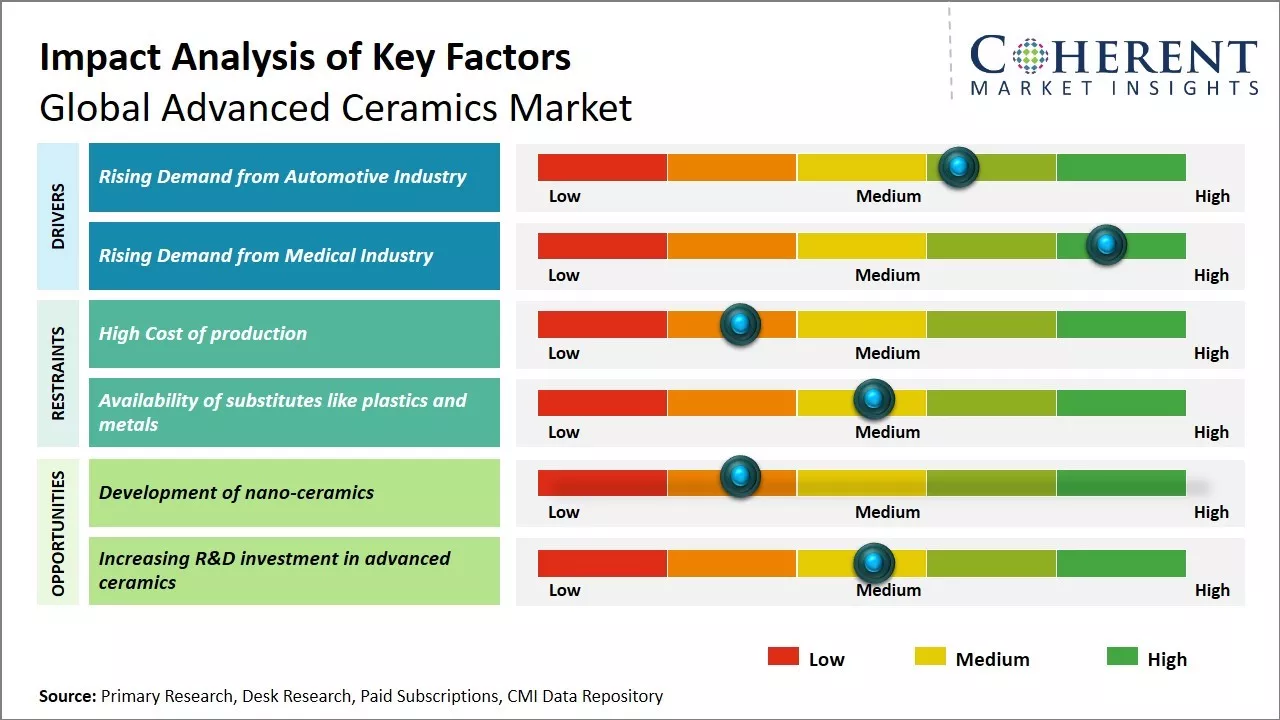
Discover market dynamics shaping the industry: Download Free Sample
The growing demand from various end-use industries such as electrical & electronics, transportation, medical, and industrial goods is driving the market growth. Advanced ceramics find wide applications in these industries owing to their properties such as strength, hardness, electrical conductivity, thermal stability, and corrosion and wear resistance. The market is witnessing increasing usage of advanced ceramics in electric vehicles owing to their high strength-to-weight ratio and stability at high temperatures. Moreover, the rising demand for ceramics from the medical industry for implants, dental crowns, hip replacement, and other prosthetics is supporting the market growth. The innovative applications of ceramics including ceramic matrix composites and piezoelectric ceramics are expected to open new growth avenues for the advanced ceramics market.
Rising Demand from Automotive Industry
The advanced ceramics market has witnessed significant growth in demand from the automotive industry in recent years. Ceramic materials such as alumina, zirconia, and silicon carbide are increasingly being used in automotive components that require high strength, hardness, corrosion, and temperature resistance. Ceramic brake discs and pads provide better braking power and longer lifespan than conventional grey iron discs. They also help reduce the overall weight of the vehicle, thereby improving fuel efficiency. Many automotive manufacturers have started utilizing ceramic brake systems in luxury and sports vehicles. Apart from brakes, advanced ceramics find wide applications in timing systems, turbochargers, and exhaust sensors due to their ability to withstand high exhaust gas temperatures. The demand for lighter and more fuel-efficient vehicles has prompted automakers to replace metal parts with advanced ceramics wherever feasible. Ceramic parts are now commonly being used in catalytic converters for pollution control. Both particulate filters and NOx storage reduction (NSR) catalysts employ advanced ceramics to efficiently reduce toxic emissions from diesel engines. The growing environmental regulations regarding vehicle emissions will further spur the replacement of metallic components with ceramics.
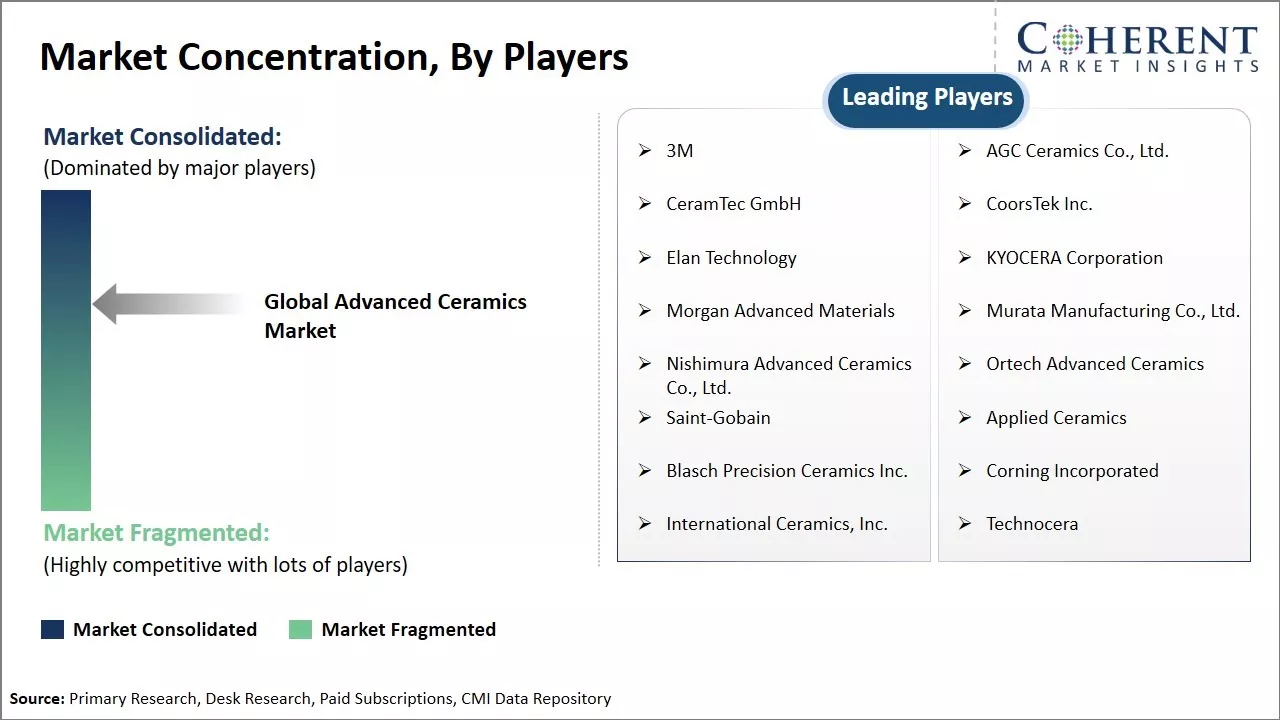
Get actionable strategies to beat competition: Download Free Sample
Rising Demand from Medical IndustryThe advanced ceramics industry is witnessing rising popularity and proven benefits of ceramic materials in medical applications. Ceramics continue to replace traditionally used implant materials like stainless steel and titanium thanks to their unmatched biocompatibility. Zirconia, hydroxyapatite, bioglass, and alumina based ceramics have become gold standards for artificial hip, knee, and dental implants due to their ability to effectively bond with living tissue. They mimic natural bone properties and integrate harmoniously with the body. Ceramic tooth crowns and bridges offer a durable and aesthetically pleasing alternative to amalgam or composite fillings. The increasing consumer demand for cosmetic and preventive dentistry will promote the usage of ceramics.
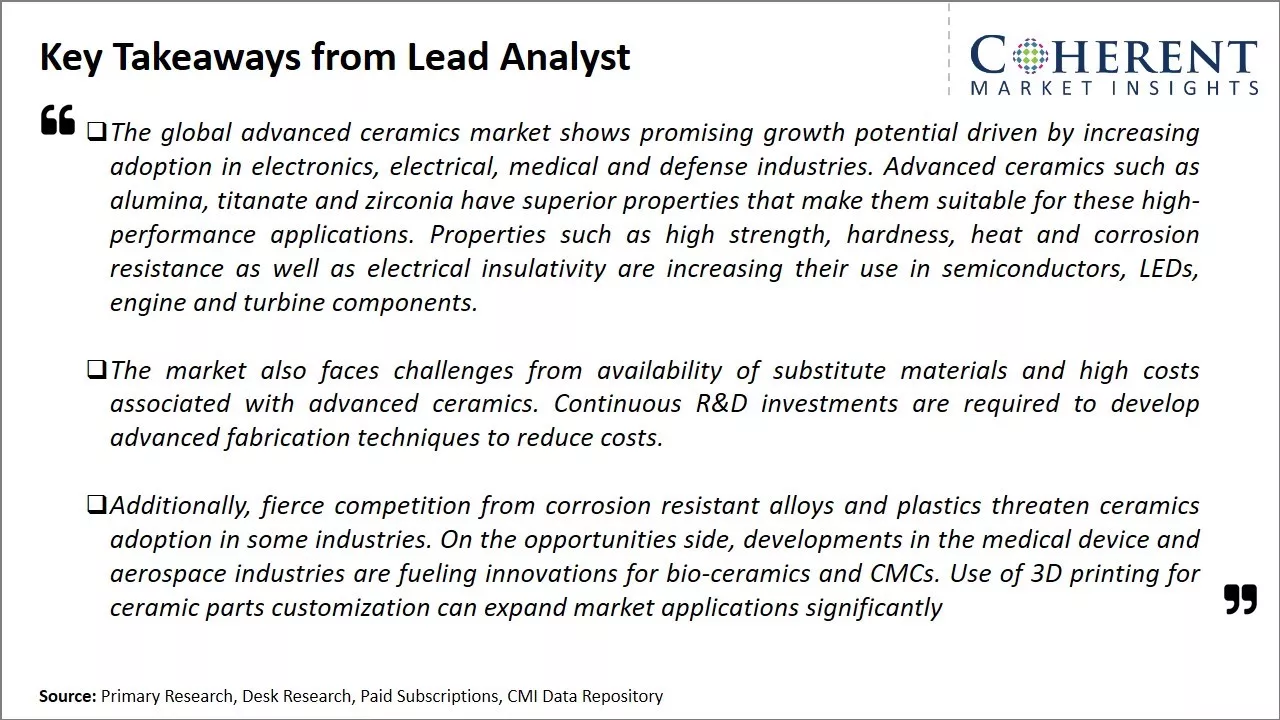
To learn more about this report, Download Free Sample
Challenges: High Cost of productionAdvanced ceramics are difficult to produce due to their complex molecular structure which requires very high processing temperatures. This makes mass production expensive. Additionally, their brittle nature also limits applications. The market also suffers from low penetration in end use industries like medical devices. Greater awareness and adoption is needed. Further, being a highly technical and niche market, it struggles with a lack of skilled labor and difficulties in scaling up production.
Opportunities: Development of nano-ceramics
The field of nano-ceramics holds immense promise to drive future innovation in advanced ceramics. Ceramic materials engineered at the nanoscale have the potential to unlock unprecedented properties like superior strength, thermal conductivity, and chemical inertness. As material science progresses towards atomic-level control of structure and composition, nano-ceramics could revolutionize industries that depend on advanced ceramics. Their enhanced and tunable characteristics open up new application frontiers in areas like electronics, energy, aerospace, and biomedicine. Several nations are invested in nurturing nano-ceramic R&D to gain leadership in this emerging sector. For instance, the U.S. allocated $3 billion towards nanotechnology initiatives focusing on energy, healthcare, and advanced materials as part of its National Nanotechnology Initiative 2021-2026 plan. This includes funding for scaling up the production of nano-ceramic components which can withstand high pressures and temperatures. Meanwhile, the U.K. launched a USD 112.79 million Graphene Flex Fund in 2021 to facilitate the commercialization of graphene and other 2D materials. Several projects related to utilizing these atomically-thin layers to reinforce ceramic matrices and endow them with new functionalities for applications in water filtration, solid state batteries, and implantable devices.
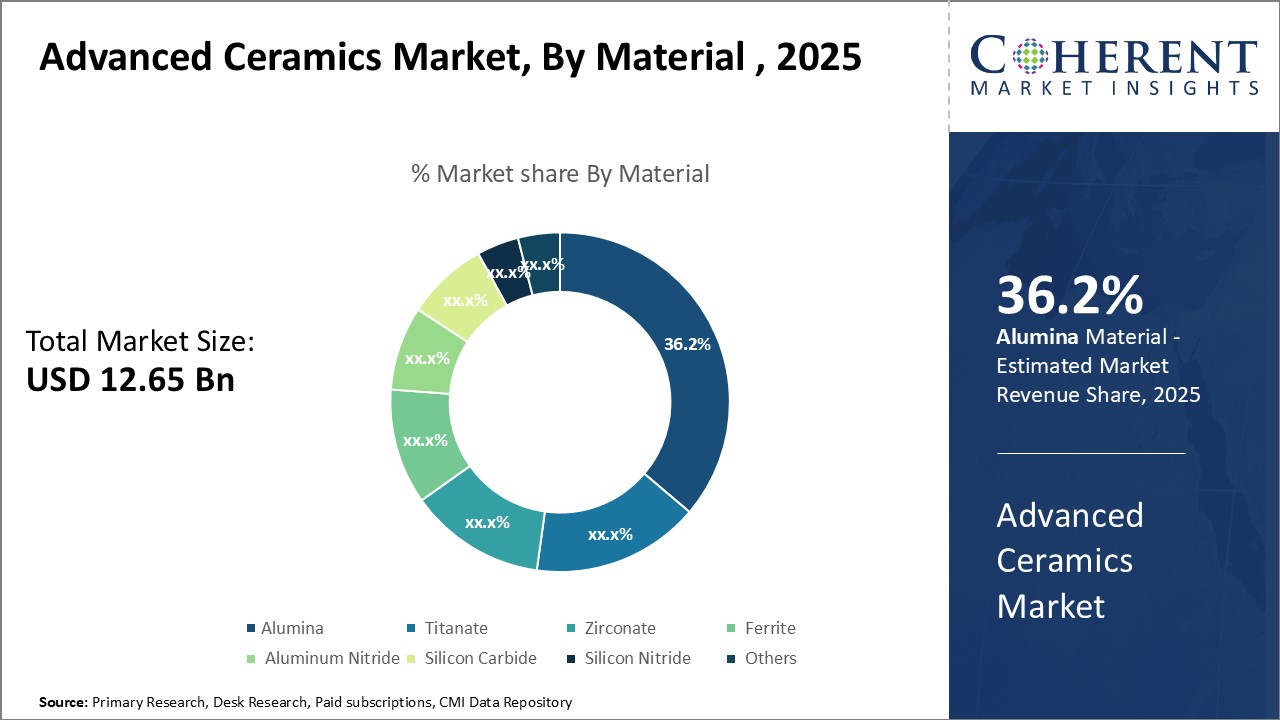
Discover high revenue pocket segments and roadmap to it: Download Free Sample
Insights by Material: Reliability Drives the Alumina DemandIn terms of material, alumina contributes the 36.2% share of the market owing to its reliability IN 2025. Alumina ceramic possesses high strength even at elevated temperatures, retaining over 90% of room temperature strength up to 1,600°C. It demonstrates high hardness and resistance to wear. Moreover, alumina has low thermal conductivity, enabling its use in applications involving high heat loads without damage. Its electrical insulating properties allow use in electronics and electrical components. Alumina also offers outstanding corrosion resistance to a wide range of chemically aggressive environments. These properties stem from alumina's exceptionally stable crystalline structure based on the alpha alumina polymorph. No other advanced ceramic exceeds alumina's durability and longevity in industrial processes. Its stability lends itself to decades of consistent and predictable performance. Such reliability enables the use of alumina in categories like industrial machinery, transportation, infrastructure, and others. Facilities rely on alumina components to operate continuously for years without failure. This dependability drives alumina's primacy over other ceramics in segments where long-term stability and lifespan take highest priority.
Insights by Application: Performance Drives the Monolithic Ceramics Demand
In terms of application, monolithic ceramics contributes the 37.2% share of the market due to their excellent performance characteristics in 2025. As non-composite structures, monolithic ceramics demonstrate properties derived purely from their crystalline atomic arrangement. They offer peers mechanical qualities like outstanding strength even under severe stresses or corrosive conditions. Monolithic ceramics can withstand high pressures, thrusts, and impacts within narrow tolerances without deformation. They also exhibit high hardness and resistance to abrasion and erosion. These traits make monolithic ceramics indispensable for demanding mechanical applications. Moreover, select varieties display premium thermal shock resistance and refractoriness. Monolithic ceramics can operate safely at elevated temperatures exceeding the capabilities of metals and plastics. Their thermostability lends them to roles in engines, furnaces, refractories, and other high-heat processes. Overall, the unsurpassed and customizable performance of monolithic ceramics underlies their widespread use where outstanding structural integrity and mechanical functioning constitute top priorities.
Insights by End-use Industry: Wide Applicability Drives Electrical & Electronics Demand
In terms of end-use industry, electrical & electronics contributes the 38.1% share of the market due to advanced ceramics wide applicability in the sector in 2025. Ceramics offer key prerequisites for miniaturized electrical components including high resistivity, low dielectric loss, and tunable dielectric constant. They also provide mechanical robustness and heat dissipation important for densely packed circuitry. Within electrical and electronics, integrated circuit substrates made of alumina and aluminum nitride help improve performance and energy efficiency. Piezoelectric ceramics like lead zirconate titanate realize ultrasonic transducers and actuators. Semiconductor packaging relies on oxidation-resistant silicon nitride coatings. Optoelectronic devices employ yttrium aluminum garnet lasers and optical fibers. Meanwhile, ceramic encapsulants protect circuits from environmental stresses and electromagnetic noise. Their diverse material compositions satisfy the array of electrical, thermal, and mechanical needs across consumer electronics, automotive electronics, telecommunications infrastructure, and others. With broad-ranging utilities, advanced ceramics see extensive deployment in the burgeoning electrical and electronics sphere to support ongoing technological advancements.
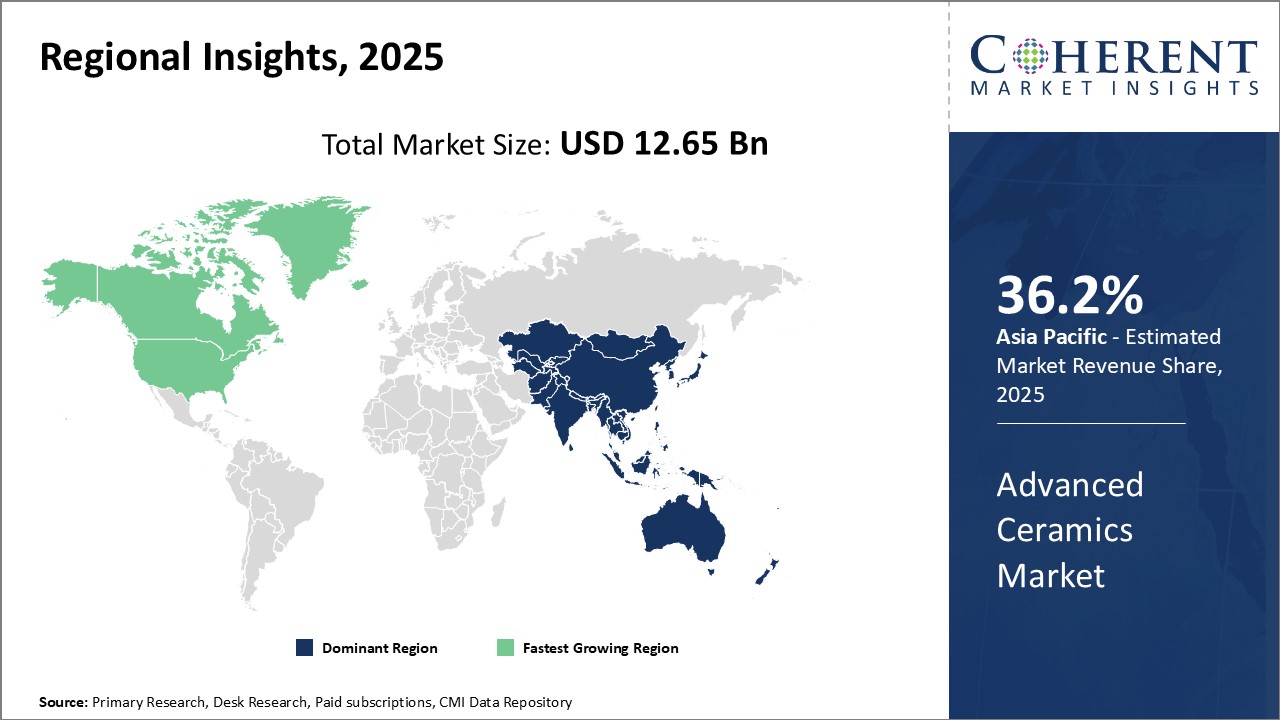
Need a Different Region or Segment? Download Free Sample
North America has consistently dominated the global advanced ceramics market over the past decades and is expected to account for 36.2% of the market share in 2025. The region is home to leading manufacturing industries such as aerospace & defense, medical devices, and semiconductor where advanced ceramics applications have found widespread use. Major advanced ceramic producers like CoorsTek, 3M, and Kyocera have presence across cities in the U.S. providing strong supply network to various end users. This has created economies of scale for the ceramics industry and made the region self-reliant for its requirements. Stringent manufacturing standards in industries like aerospace demand best quality materials. Advanced ceramics produced in North America comply with specifications like IS0 and ASTM due to presence of major certification bodies. Production facilities also adhere to quality norms of regulators like FDA, further boosting customer confidence. North American exports of advanced ceramics have also increased over the past five years. Countries in Europe and Asia Pacific look up to the region for high-performance ceramics used in strategic industries.
While North America leads in terms of current demand, the Asia Pacific region is expected to witness the highest growth going forward. Nations like China, India, and Japan are rapidly industrializing with focus on sectors that use advanced ceramics. Along with growing manufacturing industries, rising domestic demand for electronics and alternative energy devices will propel ceramics requirement. Cheap labor and availability of raw materials in the region provide natural advantage to APAC producers. Their prices of ceramics are also lower than imports, making purchases more cost-effective for industries looking to establish facilities in the region. If Asia Pacific sustains the current pace of development, it may surpass North America to become the dominant market for advanced ceramics in the coming decade.
Advanced Ceramics Market Report Coverage
| Report Coverage | Details | ||
|---|---|---|---|
| Base Year: | 2024 | Market Size in 2025: | USD 12.65 Bn |
| Historical Data for: | 2020 To 2024 | Forecast Period: | 2025 To 2032 |
| Forecast Period 2025 to 2032 CAGR: | 6.4% | 2032 Value Projection: | USD 19.55 Bn |
| Geographies covered: |
|
||
| Segments covered: |
|
||
| Companies covered: |
3M, AGC Ceramics Co., Ltd., CeramTec GmbH, CoorsTek Inc., Elan Technology, KYOCERA Corporation, Morgan Advanced Materials, Murata Manufacturing Co., Ltd., Nishimura Advanced Ceramics Co., Ltd., Ortech Advanced Ceramics, Saint-Gobain, Applied Ceramics, Blasch Precision Ceramics Inc., Corning Incorporated, International Ceramics, Inc., and Technocera |
||
| Growth Drivers: |
|
||
| Restraints & Challenges: |
|
||
Uncover macros and micros vetted on 75+ parameters: Get instant access to report
*Definition: The global advanced ceramics market involves the manufacturing and production of advanced technical ceramic materials as well as various components, parts, and products made from advanced ceramics. These advanced technical ceramics generally have high purity, fine microstructure, superplasticity, high-temperature resistance, corrosion resistance, wear resistance, and other performance advantages. Advanced ceramics play a key role in many modern industries such as electronics and electrical equipment, transportation, machinery, environmental protection, medicine, aviation, and aerospace.
Share
Share
About Author
Vidyesh Swar is a seasoned Consultant with a diverse background in market research and business consulting. With over 6 years of experience, Vidyesh has established a strong reputation for his proficiency in market estimations, supplier landscape analysis, and market share assessments for tailored research solution. Using his deep industry knowledge and analytical skills, he provides valuable insights and strategic recommendations, enabling clients to make informed decisions and navigate complex business landscapes.
Missing comfort of reading report in your local language? Find your preferred language :
Transform your Strategy with Exclusive Trending Reports :
Frequently Asked Questions
Joining thousands of companies around the world committed to making the Excellent Business Solutions.
View All Our Clients